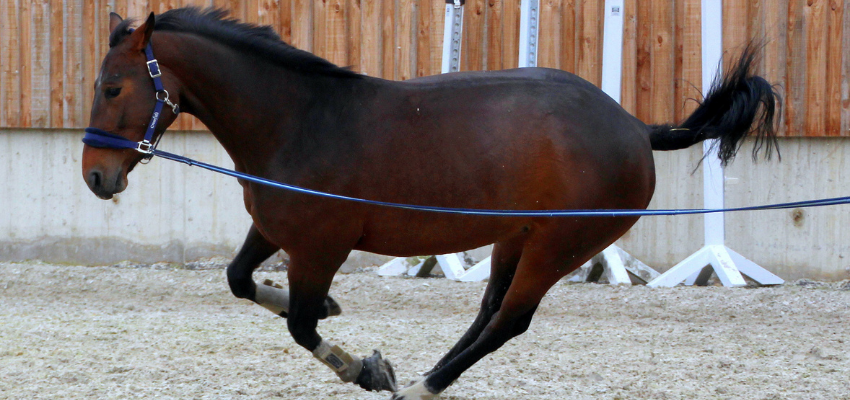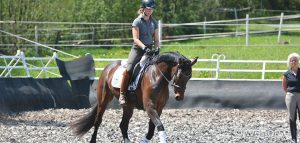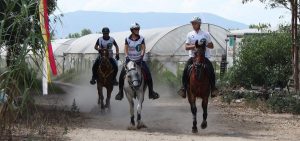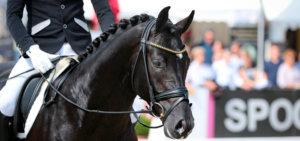A horse bucking because he feels good is one thing but bucking under saddle is another, ranging from fairly harmless little bunny hops to terrifying bronc shows. Usually, a horse bucking under the saddle has a reason; the usual culprit and easiest to avoid is a bit too much feed and not enough exercise. Another is the need to escape some sort of pressure; whether this is physical pain or badly fitting gear. The one that is perhaps the most dangerous and difficult to fix is habitual bucking- he has learned by bucking the pressure stops, this is often the bronc bucking, not only terrifying but often impossible to “just sit out”.
Summary
- The Good Things in Life
- Letting Off Steam
- Does Lunging Really Help?
- Is Your Horse Uncomfortable?
- Ask for Professional Help
- “Riding” From the Ground
- Ever Wondered How Dolphins Are Trained?
- Refining Your Brakes
- Timing, Patience and Feeling
The Good Things in Life
Maybe you’ve bought a gorgeous new horse and want him to look round and shiny….only problem is he’s jumping out of his skin and you’ve either hit the dirt already or are worried you will do soon. This is probably the easiest “bucking problem” to cure, cut out or reduce the hard feed! The majority of horses will do very well on just good quality grass hay, unless they’re competing regularly or in a lot of work, just hay will help tame your fresh beast, until you feel safe and think he’s ready for hard feed again.
Letting Off Steam
However, especially in winter, every horse needs the chance to let off steam and be a horse. Letting them free in the indoor is a great way to do this but in order to avoid injuries make sure they are warmed up first, 20 mins in the walking machine, or even better, in hand. Why better? Because this is the perfect chance to help your horse learn what you expect from him, self control. That when you stop, he stops. Maybe some leg yielding on a circle, or even travers, shoulder in and half pass. Yes, all possible from the ground and brilliant for warming up as well as an avenue for excess energy in body and mind. Once he’s warm, ideally you have a helper so that you can prevent any sliding stops and spinning in the corners. You can send him around the outside track, in trot and canter, both directions. 20 mins altogether of trot and canter is usually plenty for most horses, even very energetic ones. Walk again afterwards until he’s cooled down, using this time to practise more ground work. Doing this once, or even twice, a week means he has a chance to let off steam when you’re not on him, making the chances of him bucking under you far smaller and preventing it from happening easier.

Does Lunging Really Help?
Lunging before you ride is another option and probably the most popular, however, what we want to avoid is over lunging. We want to lunge the horse in a way that helps him warm-up, not to wear him out. A tired horse cannot learn. Letting him hoon around on the lunge to get rid of any excess energy when he’s fresh is fine now and then but sometimes this can lead to lunging every time we ride, and rather than the bucking disappearing, he simply gets fitter and fitter, with even more energy for bucking. What we ideally want is to change our mindset, and that of our horse, so that lunging is part of his work routine and teach him to channel his energy into something other than bucking. This might be lots of transitions, spiraling the circles down, spiraling back out, going over poles, not just around and around in endless circles. Expect him to behave on the lunge as you want him to under saddle, so that you can go into the round yard or arena, ask him to walk on the lunge and he waits for you to let him know he can trot and canter, exactly as you would if you were in the saddle. Racing off and him deciding the tempo isn’t what we want under saddle, nor is it on the lunge. This not only means he will start to learn that bucking is not an option but also prevent injuries from zooming around wildly on the lunge and also means you can lunge him for shorter and shorter periods before getting on, until you don’t have to lunge before every ride. Are you looking for creative ideas for groundwork with your horse? Then visit our website. There, you will find many different exercises explained step by step.
Is Your Horse Uncomfortable?
Horses thrive on consistency and knowing what we expect of them. This is not about being “tough” or “showing him who’s boss”, it is being consistent and aware of what you are asking. They also want to find a way to avoid undue pressure, which leads to the next reason for bucking; pressure or pain. If a horse has kissing spines, a saddle that pinches, or a rider that is unbalanced, they might search for an escape, and this can lead to bucking. In this case, getting their teeth checked, and having a vet look them over is the first step. Checking if the saddle fits is the next step. Some horses are saints and won’t say anything, however, some horses are fairly sensitive and will make it clear they’re uncomfortable. Our job is to figure out what’s bothering them before it gets to the stage of bucking. Is your horse uncomfortable on the lunge without a saddle? Or only once a rider hops on that he gets upset? There are some horses that will be almost asleep at the walk and once asked to trot suddenly wake up and start bucking. In this instance, sending them forwards in trot and canter on the lunge and lots of transitions to wake them up, until you can get on without worrying about a volcano underneath you. Or some walk trot transitions in hand, for 5 mins before you get on, might help too. However, checking their back would be still a good idea, are they sensitive when you groom them? Is their back better after a few days off, or only lunging? Maybe your saddle doesn’t fit as well as you think.
Ask For Professional Help
If a horse is bucking out of habit, perhaps during the breaking in process the girth was done up too tight and too fast and the “bucking out” didn’t go to plan, or he has simply learnt that the rider leaves him alone if he starts bucking, it can be really difficult to untrain and is also very dangerous. If your horse really bucks, getting the help of a professional is your best bet.
“Riding” From the Ground
However, there is still a lot you can do from the ground to help.
One method is pressure/ release training so that you can show them what behavior you would like when they are worried, one of the most helpful is them learning by dropping their head and neck the pressure will go away, as this in itself is relaxing. You might be starting a young horse that is worried about you getting on. Teaching them to drop their neck will also help them let go through their back, fabulous if you have a horse that tends to be “cold backed”. This work can build their trust in you and self-confidence, creating yet another path to teaching them there is an alternative to bucking.
Ever Wondered How Dolphins Are Trained?
Clicker training! You may have never heard of it and are curious about how it works. If you have tried it and feel like you need an extra pair of hands for the clicker and treats, try whistling or coughing instead of clicking. Most horses figure it out very very quickly and it can be a great way to be able to tell your horse “yes, that behavior is what I want”, for instance teaching them to stretch their nose down and forwards on the lunge, great not only to take their mind off bucking and concentrate on what you want but for relaxing and building up their back and neck muscles. You might need a lot of practice to get the hang of the timing and if you’re worried you have to run around with a bucket of treats constantly rewarding your horse, don’t worry, once they’ve learnt a behavior, verbal praise is often enough. The clicker training can then be integrated into your ground work and even ridden work, providing an easy and clear way to reward the behavior you want.

Refining Your Brakes
Another thing that can help is a neck rope. A fairly thin, flexible rope is ideal as you can hold it more easily together in your hand with your reins, gives a more direct message and most horses react brilliantly. Think of it as adding a hand brake to your horse, if not used with feeling and timing they will soon switch off to it. As with any training, introduce it from the ground first, establishing the response you want and expect, before trying from the saddle. Teaching rein back and halt from walk are usually enough if you’re using the neck rope to help prevent or stop bucking. A friend of mine used this on a young horse he was breaking in that had started bucking and it stopped the bucking completely.
Timing, Patience and Feeling
None of these methods alone are just going to magically stop a horse bucking, but with the right timing and application, can go a long way towards this goal, as well as help your horse understand what you want and expect of him. Having ruled out physical reasons for bucking, being able to “ride” your horse from the ground will also make a huge difference, keeping you safe and helping with confidence. The last thing you want is to be getting on your horse worried or anxious about whether you’ll still be in the saddle in five minutes.







